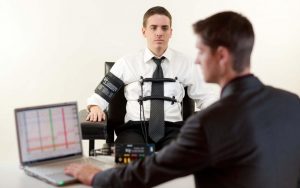body to respond; noise, sights, being touched, telling a lie, even random
thoughts. The examiner must structure the testing situation to eliminate or control extraneous
sources of reactions. For example, repeating the test questions several times controls responses
to random thoughts. The examiner’s diagnosis of deception is aninference based upon
the elimination of alternative causes of responses.
1) Respiration.
2) Electro dermal activity.
3) Cardio changes.
4) Photoelectric Plethysmograph.
The Photo Plethysmograph adds new physiological data to existing polygraph information by measuring relative changes in the total blood volume in a body segment and by rapidly
detecting any changes in pulse blood volume. The Photo Plethysmograph uses a photo-sensitive
cell to measure infrared light reflected or passed though human tissue. The light is scattered by
red blood cells so that the amount of light reaching the photo sensor after passing through the
tissue indicates the amount of blood that it had to pass through. Empirical research on the
effectiveness of the Photo Plethysmograph has revealed that this technique provides an
independent index of sympathetic arousal and that the underlying physiological principles of
the Photo Plethysmograph are scientifically based and reliable.
- Relevant Question: pertain directly to the matter under investigation.
For example:“Did you commit this crime?
(2) Irrelevant question: Totally unconnected to the matter under investigation.
For example:“Is today Wednesday?
(3) Comparison question: Only indirectly related to the matter being investigated. The
Question is designed to either provoke a lie, or to create concern about whether or not the
examinee is concealing information from the examiner.
For example: “Before the age of 20, have you ever deliberately told a serious lie, to
someone that trusted you?
Innocent Examinee
The innocent examinee is answering the relevant questions truthfully. He / she is lying to or
doubtful about the comparison questions, which now have greater signal value. He / she thus
react more or greater to the comparison questions than relevant questions.
Guilty Examinee
The guilty examinee is lying to both the comparison questions and relevant questions, but is
more concerned about him or her lie to the relevant questions because of their signal value and
fear of detection. He or she thus reacts more or greater to relevant questions than to the
comparison questions.



